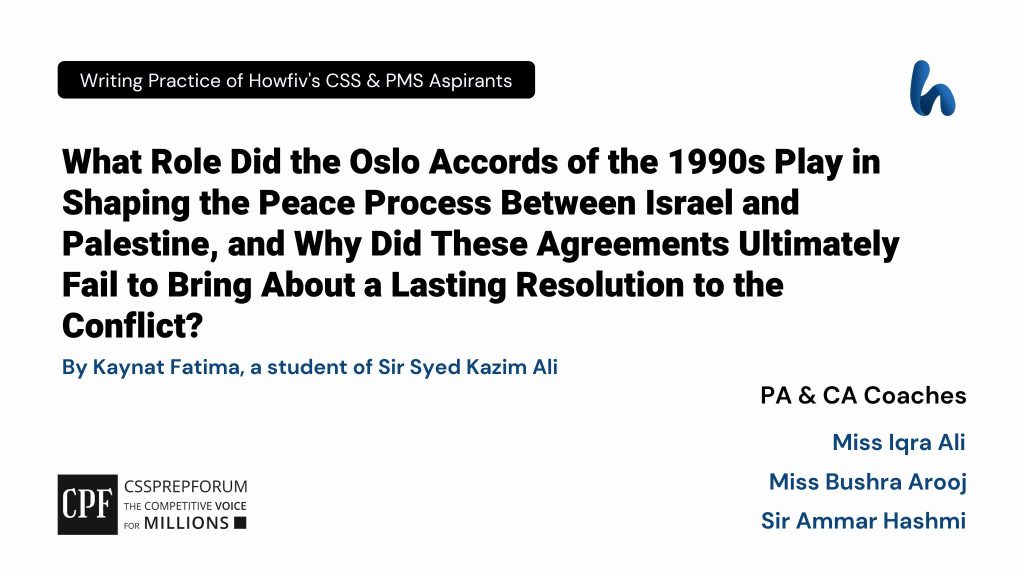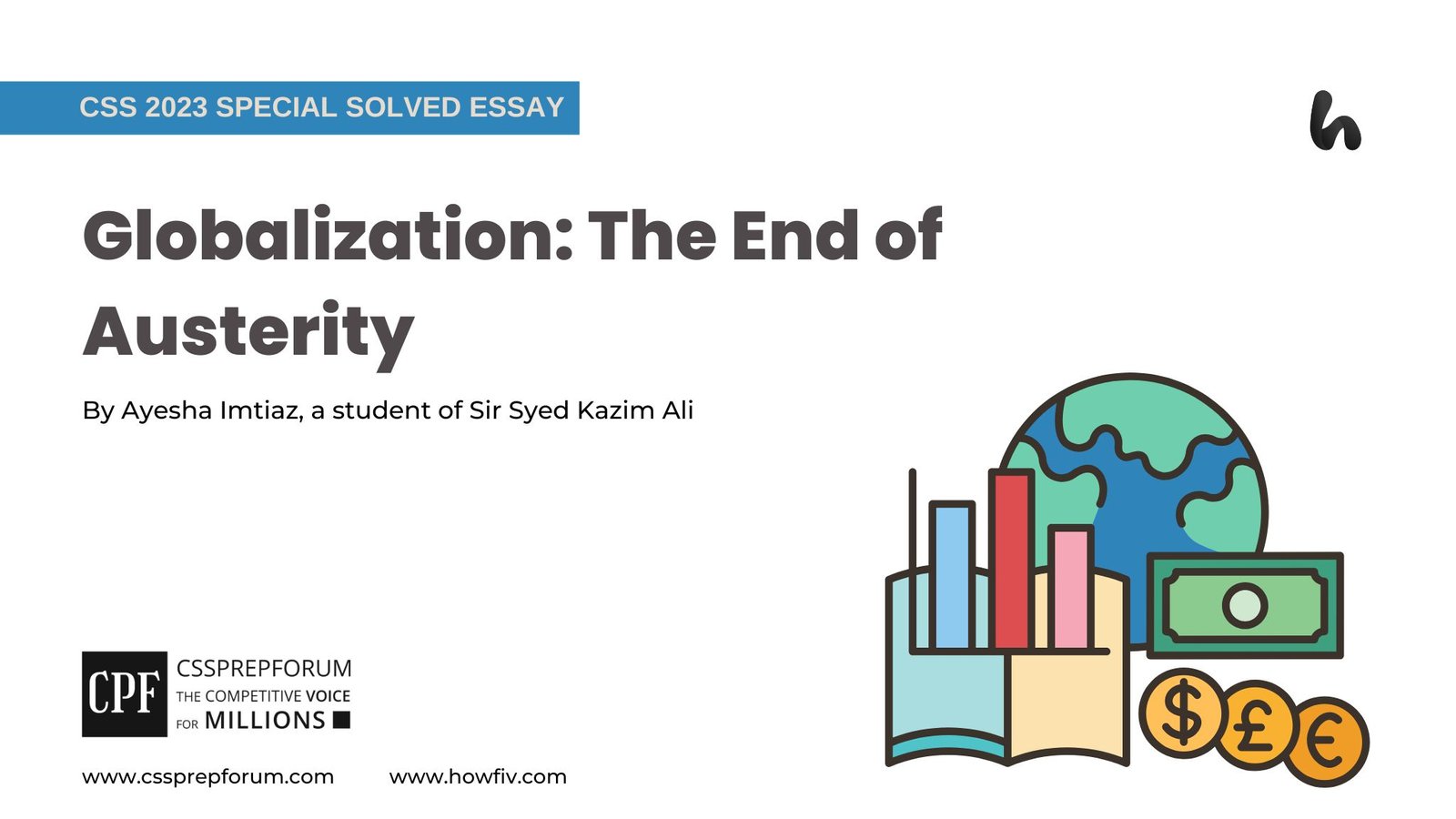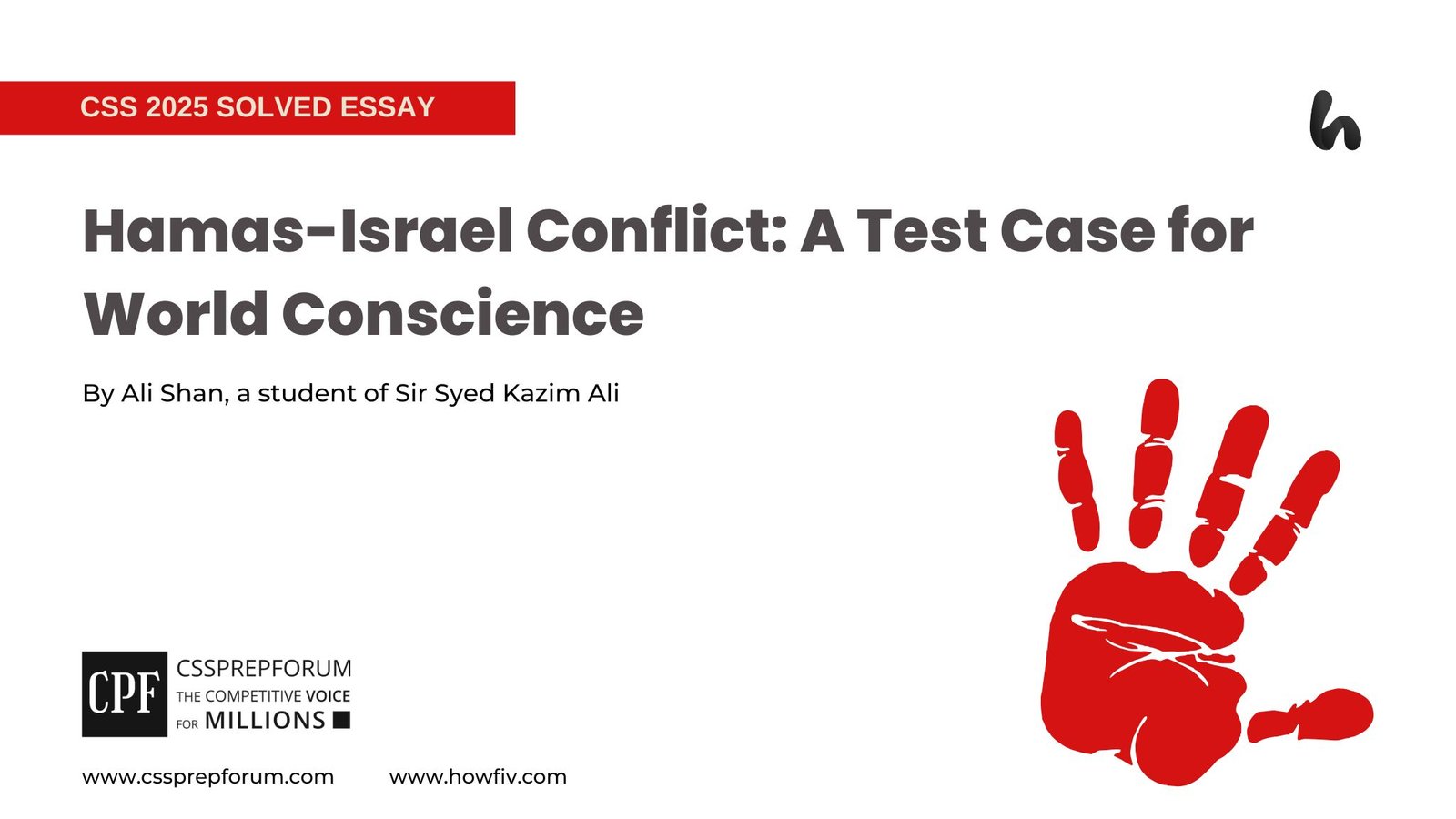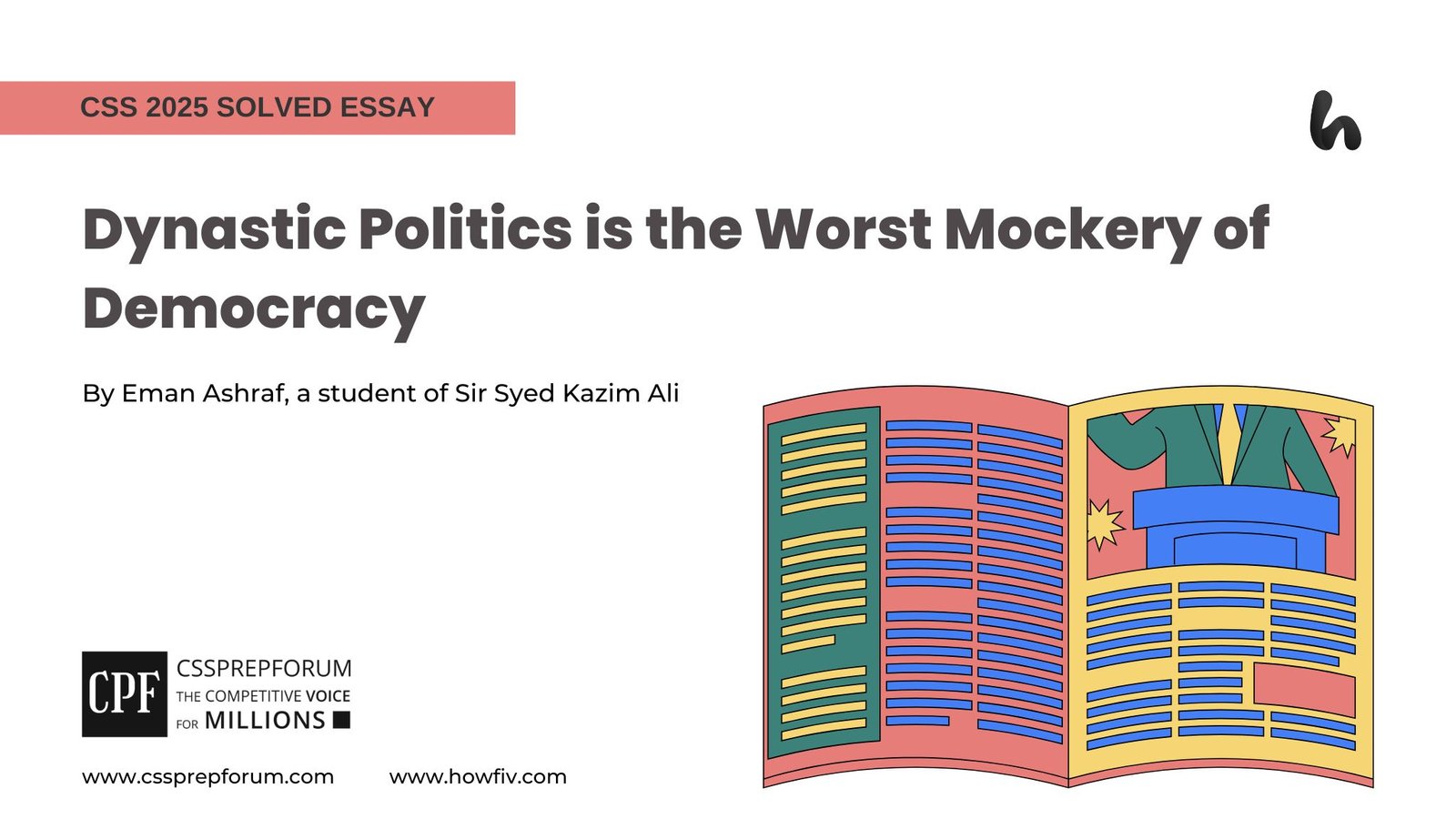CSS Current Affairs | The Oslo Accords of 1990s and the Israel–Palestine Conflict
The following question of CSS Current Affairs is solved by Kaynat Fatima under the supervision of Howfiv’s Pakistan Affairs and Current Affairs Coaches. She learnt how to attempt 20 marks question and essay writing from Sir Syed Kazim Ali, Pakistan’s best CSS and PMS English essay and precis teacher with the highest success rate of his students. This solved past paper question is attempted on the pattern taught by Sir to his students, scoring the highest marks in compulsory and optional subjects for years, and uploaded to help aspirants understand how to crack a topic or question, how to write relevantly, what coherence is, and how to include and connect ideas, opinions, and suggestions to score the maximum.

Outline
1- Introduction
2- Background History and aims of Oslo Accords
3- Role of the Oslo Accords in shaping the peace between Israel and Palestine
- ✓ Freeze settlements for peace and security cooperation
- Case in point: A peace treaty based on UNSC Resolution 242 and Resolution 338
- ✓ Proposal for self-government and empowerment of the Palestine Authority
- Case in point: Temporary accept the Palestinian Authority (PA) government and The splitting of Sections A, B, and C inside the West Bank
- ✓ Foundation of direct negotiation
- Case in point: Under the Oslo Accord, both parties recognized one another
4-Causes behind the failure of the Oslo Accords
- ✓ Delay in transformation of power to Palestine Authority
- ✓ Death of stakeholders and continuation of the settlement expansion
- ✓ Lack of sufficient international pressure and internal political instability
5- Critical analysis
6- Conclusion

Answer to the Question
Introduction
Oslo Accords (also known as the Declaration of Principles) held in the 1990s between the Israel and Palestine Liberation Organization (PLO) in reaction to the First Intifada in 1987-1991 were a milestone moment in the chasing of peace in the Middle East and Palestine. Although the Oslo Accords are the initiative and role in shaping peace in Palestine through freeze settlements, self-government, a two-state solution, and direct negotiation, the Oslo Accords are proved to be a betrayal by Israel through the continuation of settlement, delay of decisions for five years in major issues, death of stakeholders, and apartheid regime. The Accords did not effectively resolve the conflict. The Oslo Accords were bitterly opposed by Edward Said, who called them “a tool of Palestinian give up, and compared the Accords with the Treaty of Versailles.” Oslo Accords were initially seen only as a bridge toward ratifying a formal peace treaty between Israel and PLO that would end decades of conflict. Still, unfortunately, these Accords failed to bring peace. Thus, this question is about the role of the Oslo Accords of the 1990s in shaping the peace negotiations between Palestine and Israel and the explanations for why the Accords haven’t been able to end the conflicts permanently.
Background History and aims of Oslo Accords

Before moving down the ladder, it is essential to know about the background history of the Israel and Palestine conflicts; in the 1880s, Zionists (Jews) began to immigrate to Palestine, and in 1897, they demanded their state. After WWI, in 1916, the Sykes-Picot Agreement was signed, and the Middle East was divided between France and Britain; in 1917, under the Balfour Declaration, the British accepted the need to demand their homeland for Jews, but the problem was not solved. In 1947, the matter was referred to the United States, and the UN proposed the plan to divide Palestine into States, allocating 44% of the area to Arabs and 56% of the area to Jews. In 1948, the British withdrew from Palestine, and the conflict increased and gave way to war. 1st war was held between Israel-Arab in 1947-49, 2nd in 1952, 3rd 1967 (six-day war), and 4th in 1973 (Yom Kippur); the 1st Intifada was in 1987-1991 and ended with the Oslo Accord in 1993 as peace accords between the PLO and Israel. On September 3, 1993, US President Clinton, Arafat, the head of the Palestine Liberation Organization (PLO), and Israeli Prime Minister Yitzhak signed the First Oslo Accord. These Accords were based on a five-year interim period; after these five years, the actual decision was made on water, mineral, and natural resources. The self-government was also transferred after these five years. Three main objectives were Israel’s withdrawal from the West Bank and Gaza Strip, a self-governance plan, and mutual negotiation and acceptance.
What role did the Oslo Accords of the 1990s play in shaping the peace process between Israel and Palestine?
- ✓ Freeze settlements for peace and security cooperation
Similarly, in the Oslo Accords of 1993 and 1995, the first and foremost aim was the freeze of illegal settlements in Palestine and the establishment of security and a peace treaty in the Middle East. These were the peace process through mutual negotiation and the two-state solution. Peace was achieved under UNSC Resolution 242, which is for peace of the land and secure border, and Resolution 338, about a ceasefire within 24 hours. Oslo Accords’ aims and motives were the freeze of illegal settlements in Palestine and the transformation of power to the Palestine Authority, the withdrawal of forces of Israel from the West Bank area and the area of Gaza, end of war and conflict, and demilitarization on both sides PLO and Israel. Thus, the Oslo Accords were the base for the end of illegal settlements, peace, and security cooperation between PLO and Israel through cooperation.

- ✓ Proposal for self-government and empowerment of the Palestine Authority
Moreover, the Oslo Accord was the proposal for self-government in Palestine and the empowerment of the Palestine Authority. These Accords focused on the two-state solution. Further, the Oslo Accords consisted of temporary accords and the establishment of the Palestinian National Authority, which centred on the West Bank and Gaza Strip’s partial Palestinian autonomy. Along with dividing the West Bank into three categories, A, B, and C, it also split the governments of Israel and Palestine. According to Saeb Erekat, the Secretary-General of the Palestine Liberation Organization, rather than two states, Israel seeks one state but two systems. This accord did not mark the international border between Israel and Palestinian states, the status of Jerusalem was not defined in this accord, Palestinian immigrants’ right of return, and the division of water, natural resources, and minerals was not solved in this Accord. The Oslo Accords were ineffective and did not establish a definite Palestinian state and establish peace. Hence, the Oslo Accord was the proposal for self-government and empowerment of the Palestine Authority.
- ✓A foundation of direct negotiation
Moving towards the role of the Oslo Accord in shaping peace, the Oslo Peace Accord was held between Israel and PLO in 1993 in Oslo, Norway, as a foundation of negotiation for peace. Israel established peace agreements with Anwar Sadat, the president of Egypt, in 1978 under the Camp David Accords and recognized Israel; Israel considered PLO a terrorist organization and was not ready for peace talks with them. In 1993, the first direct peace negotiations were held between PLO and Israel. Further, these peace talks were held between Yasser Arafat, Yitzhak Rabin, and Bill Clinton. PLO recognizes Israel as a separate state, and Israel recognizes PLO as a liberal organization. The Camp David Accords considered the bedrock for Middle East peace, served as a blueprint for the Oslo Accords. In the Oslo I Accord, the parties signed the Letters of Mutual Acceptance, acknowledging each other, and Israel admitted the PLO as the only representation of the Palestinian people. This was considered an initiative for the peace process in Palestine. Thus, the Oslo Accord was the foundation of the peace process and direct negotiation between Israel and PLO.
Why did these agreements ultimately fail to bring about a lasting resolution to the conflict?
- ✓ Delay in transformation of power to Palestine Authority
Moving down the ladder, it is essential to talk about the reasons behind the failure of these agreements ultimately to bring about a lasting resolution to the conflict. First, there was a delay in transforming power to the Palestine Authority. These were interim agreements; some decisions were not tackled in these accords. They decided on the two-state solution but did not mark the border between the two nations; some decisions were delayed for five years, and the final decisions came after the five-year dialogues. Further, power transformation and decisions on water and natural resources were delayed for five years. In his book, unending concessions do nothing more than prolong the Israeli occupation, which Israel maintains with the authorization of the Palestinians while posing as a peacemaker. Israel was not a follower of peace; they wanted to control Palestine under the guise of peace. The Human Rights Watch (HRW) in 2021 called the amount to the crime of apartheid about the systematic oppression of Palestinians and inhumane acts. Thus, the delay in the transformation of power to the Palestine Authority is the failure of the Oslo Peace Accords.
- ✓ Death of stakeholders and continuation of the settlement expansion
Moreover, after the death of stakeholders, Israel, despite the agreement, continued the settlement expansion in the Gaza Strip area and the area of the West Bank, which was the cause of the failure of the Oslo Peace Accords. Settlements were made possible once again by the assassination of Yitzhak Rabin and the death of Arafat. The accords were similar to Britain’s colonial nature, and Israel’s persistence in the settler-colonial framework views Palestinians as the oppressed people and Israelis as the oppressors. Edward Said, a strong competitor of the Oslo Accords, predicted the tragic situation and wrote an article in review of the book “The Morning After”, which he called “common sense”, which means that it is a flawed agreement that unravelled after 1993; nothing more, nothing less. Said prediction was proved right, which was the opposite of the Oslo Accords and called the “Matrix of control” by the Israeli government and that interlocking the Palestine territory by the system of Military Administration and settlements in the occupied Palestinian territory. Hence, despite the agreement, Israelis continued the settlement expansion in the Gaza Strip area, and the area of the West Bank is the cause of the failure of the Oslo Accords to bring about a lasting resolution to the conflict.
- ✓ Lack of international pressure and internal political instability
Moreover, the lack of international pressure on the application of these accords and internal instability and unrest were the causes of the failure of the Oslo Accords to bring about a lasting resolution to the conflict. The gruesome murder of Yitzhak Rabin might be the root of the turmoil; who was the leader of Israel and a member of the Oslo Accord from the side of Israel? The cause of his murder was the reaction of the people who were against the Oslo Accords. A large portion of the Palestinian and Israeli population were against the Accords. Palestinian, Hamas, and PIJ were against the Accords and started suicide bombings and attacks. Edward Said compared to the Treaty of Versailles, which was also based on the oppression, injustice, and grabbing of the people’s fundamental rights. On the other side, extreme right Israelis were against the Oslo Accords as well by saying that PLO was not able to peace talks, and a right-wing Israeli terrorist killed Y. Rabin in 1995 because he had signed the Oslo Accords. The West Bank had fragmented into different parts, and the Gaza Strip had been blockaded, and many critics called it an “open-air prison”. Thus, many people believe that the idea of a Two-Nation solution is dead; the lack of international pressure on the application of these accords and internal instability and unrest were the causes of the failure of the Oslo Accords.
Critical analysis
Critically, the Oslo Accords are a modification of the Alon Plan, which the Israeli Minister presented after the six-day war; in this plan, he proposed the plan to retain control over the West Bank area and the area of the Gaza Strip and the limited autonomy to Palestine. This is right. The Oslo Accords were the modification of the Alon Plan because, under the guise of peace Accords, Israel controlled the West Bank and continued the settlements, and also limited autonomy to Palestine under the name of self-government and transformation of powers after the five years, which were not fulfilled. The continuation of settlements can also be compared with what the Colonizers did in South Africa and the Subcontinent under the name of enlightenment and peace. Hence, the only solution to these conflicts is to move away from the Two-Nation solution, and the international community should focus on this issue and try a democratic approach to resolve the dispute, which can establish peace, harmony, equality, and justice in the territory and the Middle East.
Conclusion
In conclusion, the Oslo Accords were the initiative and role in shaping peace in Palestine through self-government, a two-state solution, and direct negotiation; however, the Oslo Accords were proved to be a betrayal by Israel through the continuation of settlement, delay of decisions for five years in significant issues, and apartheid regime. “The Oslo Accords contributed to an apartheid-type regime in the Gaza area and the area of the West Bank,” claims Haidar Eid. The Oslo Accords led Palestine to segregation, oppression, injustice, and equality by the Israeli colonial power. The Oslo Accords were initially intended to serve as a means of bridging the gap between Israel and the PLO until a formal peace treaty was ratified, ending decades of hostilities. Regrettably, however, these Accords did not result in peace.

CSS Solved Past Papers’ Essays
Looking for the last ten years of CSS and PMS Solved Essays and want to know how Sir Kazim’s students write and score the highest marks in the essays’ papers? Then, click on the CSS Solved Essays to start reading them.
CSS Solved Essays
CSS Solved General Science & Ability Past Papers
Want to read the last ten years’ General Science & Ability Solved Past Papers to learn how to attempt them and to score high? Let’s click on the link below to read them all freely. All past papers have been solved by Pakistan’s top CSS GSA coach having the highest score of their students.
General Science & Ability Solved Past Papers











